Periodic and Axial Perturbations of Chaotic Solitons in the Realm of Complex Structured Quintic Swift-Hohenberg Equation
Abstract
1. Introduction
2. The Description of RMESEM
- Next, we hypothesise the following series-based solution for the NODE in (6) using the solution of the extended Riccati ODE:In this instance, represents the solution to the resulting extended Riccati ODE, and the variables and represent the unknown constants that must be calculated afterwards.where and r are invariables.
- Next, when (7) is incorporated in (6) or the equation resulting from the integration of (6), all the terms of are combined into an equal ordering. An expression in terms of is produced when this procedure is used. We obtain an algebraic system of equations describing the variables and with additional associated parameters by setting the coefficients in this equation to zero.
- An analytical evaluation of a collection of nonlinear algebraic equations is performed through the use of MAPLE.
- Then, by computing and inserting the unknown values in Equation (7) along together with (the Equation (8) answers), analytical soliton solutions for (5) are obtained. By employing (8)’s generic solution, we can derive multiple families of soliton solutions, which are shown in Table 1:where , , and .
3. Establishing Perturbed Soliton Solutions for CQSHE
4. Graphical Discussion
5. Conclusions
Author Contributions
Funding
Data Availability Statement
Acknowledgments
Conflicts of Interest
Appendix A
Appendix A.1. Comparison with Other Analytical Methods
References
- Buceta, J.; Lindenberg, K.; Parrondo, J.M. Stationary and oscillatory spatial patterns induced by global periodic switching. Phys. Rev. Lett. 2001, 88, 024103. [Google Scholar] [CrossRef] [PubMed]
- Cross, M.C.; Hohenberg, P.C. Pattern formation outside of equilibrium. Rev. Mod. Phys. 1993, 65, 851. [Google Scholar]
- Staliunas, K.; Sanchez-Morcillo, V.J. Dynamics of phase domains in the Swift-Hohenberg equation. Phys. Lett. A 1998, 241, 28–34. [Google Scholar] [CrossRef]
- Tribelsky, M.I. Instability of Traveling Pulses in Nonlinear Diffusion-Type Problems and Method to Obtain Bottom-Part Spectrum of Schrodinger Equation with Complicated Potential. Physics 2021, 3, 715–727. [Google Scholar] [CrossRef]
- Swift, J.; Hohenberg, P.C. Hydrodynamic fluctuations at the convective instability. Phys. Rev. A 1977, 15, 319. [Google Scholar] [CrossRef]
- Aranson, I.; Assenheimer, M.; Steinberg, V.; Tsimring, L.S. Large-scale flow and spiral core instability in Rayleigh-Benard convection. Phys. Rev. E 1997, 55, R4877. [Google Scholar] [CrossRef]
- Hohenberg, P.C.; Swift, J.B. Effects of additive noise at the onset of Rayleigh-Benard convection. Phys. Rev. A 1992, 46, 4773. [Google Scholar] [CrossRef]
- Garcia-Ojalvo, J.; Vilaseca, R.; Torrent, M.C. Coupled pattern formation near threshold in a broad-area cascade laser. Phys. Rev. A 1997, 56, 5111. [Google Scholar] [CrossRef]
- Lega, J.; Moloney, J.V.; Newell, A.C. Swift-Hohenberg equation for lasers. Phys. Rev. Lett. 1994, 73, 2978. [Google Scholar] [CrossRef]
- Weiss, C.O.; Taranenko, V.B.; Vaupel, M.; Staliunas, K.; Slekys, G.; Tarroja, M.F.H. Spatial solitons in nonlinear resonators. In Soliton-Driven Photonics; Boardman, A.D., Sukhorukov, A.P., Eds.; Springer Science & Business Media: New York, NY, USA, 2001. [Google Scholar]
- Aranson, I.; Hochheiser, D.; Moloney, J.V. Boundary-driven selection of patterns in large-aspect-ratio lasers. Phys. Rev. A 1997, 55, 3173. [Google Scholar] [CrossRef]
- Aranson, I.S.; Kramer, L. The world of the complex Ginzburg-Landau equation. Rev. Mod. Phys. 2002, 74, 99. [Google Scholar] [CrossRef]
- Sanchez-Morcillo, V.J.; Roldan, E.; de Valcarcel, G.J.; Staliunas, K. Generalized complex Swift-Hohenberg equation for optical parametric oscillators. Phys. Rev. A 1997, 56, 3237. [Google Scholar] [CrossRef]
- Sanchez-Morcillo, V.J.; Staliunas, K. Stability of localized structures in the Swift-Hohenberg equation. Phys. Rev. E 1999, 60, 6153. [Google Scholar] [CrossRef] [PubMed]
- Staliunas, K. Spatial and temporal spectra of noise driven stripe patterns. Phys. Rev. E 2001, 64, 066129. [Google Scholar] [CrossRef][Green Version]
- Lega, J.; Moloney, J.V.; Newell, A.C. Universal description of laser dynamics near threshold. Phys. D Nonlinear Phenom. 1995, 83, 478–498. [Google Scholar] [CrossRef]
- Shah, R.; Hyder, A.A.; Iqbal, N.; Botmart, T. Fractional view evaluation system of Schrödinger-KdV equation by a comparative analysis. AIMS Math. 2022, 7, 19846–19864. [Google Scholar] [CrossRef]
- Alderremy, A.A.; Shah, R.; Iqbal, N.; Aly, S.; Nonlaopon, K. Fractional series solution construction for nonlinear fractional reaction-diffusion Brusselator model utilizing Laplace residual power series. Symmetry 2022, 14, 1944. [Google Scholar] [CrossRef]
- Al-Sawalha, M.M.; Khan, A.; Ababneh, O.Y.; Botmart, T. Fractional view analysis of Kersten-Krasilshchik coupled KdV-mKdV systems with non-singular kernel derivatives. AIMS Math. 2022, 7, 18334–18359. [Google Scholar] [CrossRef]
- Elsayed, E.M.; Nonlaopon, K. The Analysis of the Fractional-Order Navier-Stokes Equations by a Novel Approach. J. Funct. Spaces 2022, 2022, 8979447. [Google Scholar] [CrossRef]
- Pereira, N.R.; Stenflo, L. Nonliner Schrodinger Equation Including Growth and Damping. Phys. Fluids 1977, 20, 1733–1734. [Google Scholar] [CrossRef]
- Van Saarloos, W.; Hohenberg, P.C. Fronts, pulses, sources and sinks in generalized complex Ginzburg-Landau equations. Phys. D Nonlinear Phenom. 1992, 56, 303–367. [Google Scholar] [CrossRef]
- Bekki, N.; Nozaki, K. Formations of spatial patterns and holes in the generalized Ginzburg-Landau equation. Phys. Lett. A 1985, 110, 133–135. [Google Scholar] [CrossRef]
- Akhmediev, N.N.; Ankiewicz, A. Nonlinear Pulses and Beams; Springer: New York, NY, USA, 1997; Volume 12. [Google Scholar]
- Boardman, A.D.; Sukhorukov, A.P. (Eds.) Soliton-Driven Photonics Photonics; Kluwer Academic Publishers: Dordecht, The Netherlands, 2001. [Google Scholar]
- Trillo, S.; Torruellas, W. (Eds.) Spatial Solitons; Springer: New York, NY, USA, 2013; Volume 82. [Google Scholar]
- Sakaguchi, H.; Brand, H.R. Localized patterns for the quintic complex Swift-Hohenberg equation. Phys. D Nonlinear Phenom. 1998, 117, 95–105. [Google Scholar] [CrossRef]
- Moores, J.D. On the Ginzburg-Landau laser mode-locking model with fifth-order saturable absorber term. Opt. Commun. 1993, 96, 65–70. [Google Scholar] [CrossRef]
- Maruno, K.I.; Ankiewicz, A.; Akhmediev, N. Exact soliton solutions of the one-dimensional complex Swift–Hohenberg equation. Phys. D Nonlinear Phenom. 2003, 176, 44–66. [Google Scholar] [CrossRef][Green Version]
- Soto-Crespo, J.M.; Akhmediev, N. Composite solitons and two-pulse generation in passively mode-locked lasers modeled by the complex quintic Swift-Hohenberg equation. Phys. Rev. E 2002, 66, 066610. [Google Scholar] [CrossRef]
- Ali, R.; Zhang, Z.; Ahmad, H. Exploring soliton solutions in nonlinear spatiotemporal fractional quantum mechanics equations: An analytical study. Opt. Quantum Electron. 2024, 56, 838. [Google Scholar] [CrossRef]
- Bilal, M.; Iqbal, J.; Ali, R.; Awwad, F.A.; Ismail, E.A.A. Exploring Families of Solitary Wave Solutions for the Fractional Coupled Higgs System Using Modified Extended Direct Algebraic Method. Fractal Fract. 2023, 7, 653. [Google Scholar] [CrossRef]
- Ali, R.; Hendy, A.S.; Ali, M.R.; Hassan, A.M.; Awwad, F.A.; Ismail, E.A. Exploring Propagating Soliton Solutions for the Fractional Kudryashov–Sinelshchikov Equation in a Mixture of Liquid–Gas Bubbles under the Consideration of Heat Transfer and Viscosity. Fractal Fract. 2023, 7, 773. [Google Scholar] [CrossRef]
- Yasmin, H.; Iqbal, N. Analysis of Fractional-Order System of One-Dimensional Keller–Segel Equations: A Modified Analytical Method. Symmetry 2022, 14, 1321. [Google Scholar] [CrossRef]
- Noor, S.; Alshehry, A.S.; Shafee, A. Families of propagating soliton solutions for (3+1)-fractional Wazwaz-BenjaminBona-Mahony equation through a novel modification of modified extended direct algebraic method. Phys. Scr. 2024, 99, 045230. [Google Scholar] [CrossRef]
- Yasmin, H.; Iqbal, N. A Comparative Study of the Fractional Coupled Burgers and Hirota–Satsuma KdV Equations via Analytical Techniques. Symmetry 2022, 14, 1364. [Google Scholar] [CrossRef]
- Ali, R.; Kumar, D.; Akgil, A.; Altalbe, A. On the Periodic Soliton Solutions for Fractional Schrodinger Equations. Fractals 2024, 2440033. [Google Scholar] [CrossRef]
- Ali, R.; Barak, S.; Altalbe, A. Analytical study of soliton dynamics in the realm of fractional extended shallow water wave equations. Phys. Scr. 2024, 99, 065235. [Google Scholar] [CrossRef]
- Yasmin, H.; Alshehry, A.S.; Ganie, A.H.; Shafee, A.; Shah, R. Noise effect on soliton phenomena in fractional stochastic Kraenkel-Manna-Merle system arising in ferromagnetic materials. Sci. Rep. 2024, 14, 1810. [Google Scholar] [CrossRef]
- Ali, R.; Tag-eldin, E. A comparative analysis of generalized and extended (G’/G)-Expansion methods for travelling wave solutions of fractional Maccari’s system with complex structure. Alex. Eng. J. 2023, 79, 508–530. [Google Scholar] [CrossRef]
- Khan, H.; Baleanu, D.; Kumam, P.; Al-Zaidy, J.F. Families of travelling waves solutions for fractional-order extended shallow water wave equations, using an innovative analytical method. IEEE Access 2019, 7, 107523–107532. [Google Scholar] [CrossRef]
- Khan, H.; Barak, S.; Kumam, P.; Arif, M. Analytical solutions of fractional Klein-Gordon and gas dynamics equations, via the (G’/G)-expansion method. Symmetry 2019, 11, 566. [Google Scholar] [CrossRef]
- Khan, H.; Shah, R.; Gomez-Aguilar, J.F.; Baleanu, D.; Kumam, P. Travelling waves solution for fractional-order biological population model. Math. Model. Nat. Phenom. 2021, 16, 32. [Google Scholar] [CrossRef]
- Kai, Y.; Yin, Z. Linear structure and soliton molecules of Sharma-Tasso-Olver-Burgers equation. Phys. Lett. A 2022, 452, 128430. [Google Scholar] [CrossRef]
- Sarwar, A.; Arshad, M.; Farman, M.; Akgül, A.; Ahmed, I.; Bayram, M.; De la Sen, M. Construction of novel bright-dark solitons and breather waves of unstable nonlinear Schrödinger equations with applications. Symmetry 2022, 15, 99. [Google Scholar] [CrossRef]
- Arshad, M.; Seadawy, A.R.; Mehmood, A.; Shehzad, K. Lump Kink interactional and breather-type waves solutions of (3+1)-dimensional shallow water wave dynamical model and its stability with applications. Mod. Phys. Lett. B 2024, 2450402. [Google Scholar] [CrossRef]
- Umer, M.A.; Arshad, M.; Seadawy, A.R.; Ahmed, I.; Tanveer, M. Exploration conversations laws, different rational solitons and vibrant type breather wave solutions of the modify unstable nonlinear Schrödinger equation with stability and its multidisciplinary applications. Opt. Quantum Electron. 2024, 56, 420. [Google Scholar] [CrossRef]
- Nasreen, N.; Rafiq, M.N.; Younas, U.; Arshad, M.; Abbas, M.; Ali, M.R. Stability analysis and dynamics of solitary wave solutions of the (3+1)-dimensional generalized shallow water wave equation using the Ricatti equation mapping method. Results Phys. 2024, 56, 107226. [Google Scholar] [CrossRef]
- Kudryashov, N.A. Seven common errors in finding exact solutions of nonlinear differential equations. Commun. Nonlinear Sci. Numer. Simul. 2009, 14, 3507–3529. [Google Scholar] [CrossRef]
- Navickas, Z.; Ragulskis, M. Comments on A new algorithm for automatic computation of solitary wave solutions to nonlinear partial differential equations based on the Exp-function method. Appl. Math. Comput. 2014, 243, 419–425. [Google Scholar] [CrossRef]
- Antonova, A.O.; Kudryashov, N.A. Generalization of the simplest equation method for nonlinear non-autonomous differential equations. Commun. Nonlinear Sci. Numer. Simul. 2014, 19, 4037–4041. [Google Scholar] [CrossRef]
- Navickas, Z.; Marcinkevicius, R.; Telksniene, I.; Telksnys, T.; Ragulskis, M. Structural stability of the hepatitis C model with the proliferation of infected and uninfected hepatocytes. Math. Comput. Model. Dyn. Syst. 2024, 30, 51–72. [Google Scholar] [CrossRef]
- Kudryashov, N.A. Simplest equation method to look for exact solutions of nonlinear differential equations. Chaos Solitons Fractals 2005, 24, 1217–1231. [Google Scholar] [CrossRef]
- Vitanov, N.K. Application of simplest equations of Bernoulli and Riccati kind for obtaining exact traveling-wave solutions for a class of PDEs with polynomial nonlinearity. Commun. Nonlinear Sci. Numer. Simul. 2010, 8, 2050–2060. [Google Scholar] [CrossRef]
- Vitanov, N.K. Simple Equations Method (SEsM): An effective algorithm for obtaining exact solutions of nonlinear differential equations. Entropy 2022, 24, 1653. [Google Scholar] [CrossRef] [PubMed]
- Vitanov, N.K.; Dimitrova, Z.I.; Vitanov, K.N. Simple equations method (SEsM): Algorithm, connection with Hirota method, inverse scattering transform method, and several other methods. Entropy 2020, 23, 10. [Google Scholar] [CrossRef] [PubMed]
- Xiao, Y.; Barak, S.; Hleili, M.; Shah, K. Exploring the dynamical behaviour of optical solitons in integrable kairat-II and kairat-X equations. Phys. Scr. 2024, 99, 095261. [Google Scholar] [CrossRef]
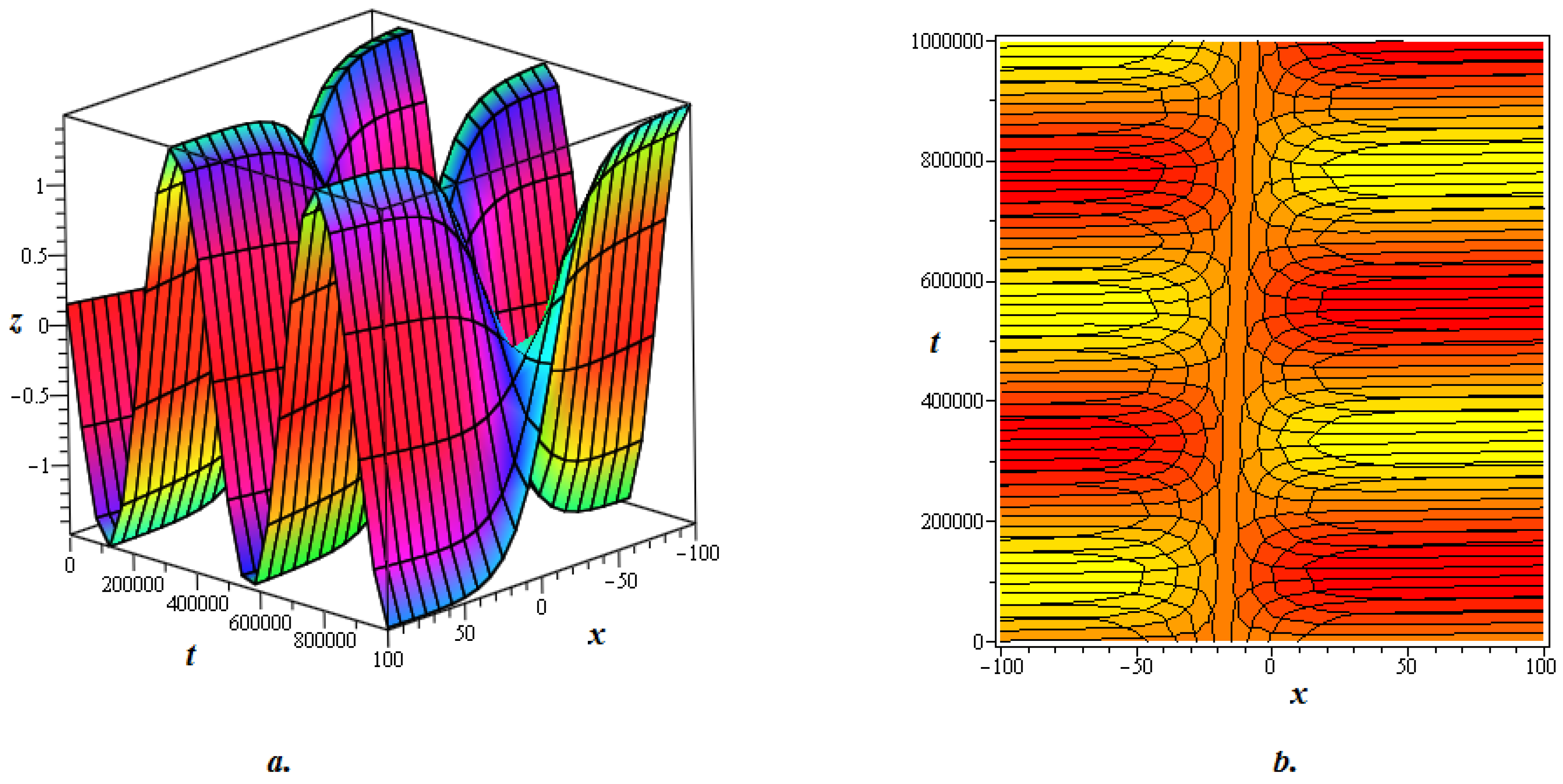

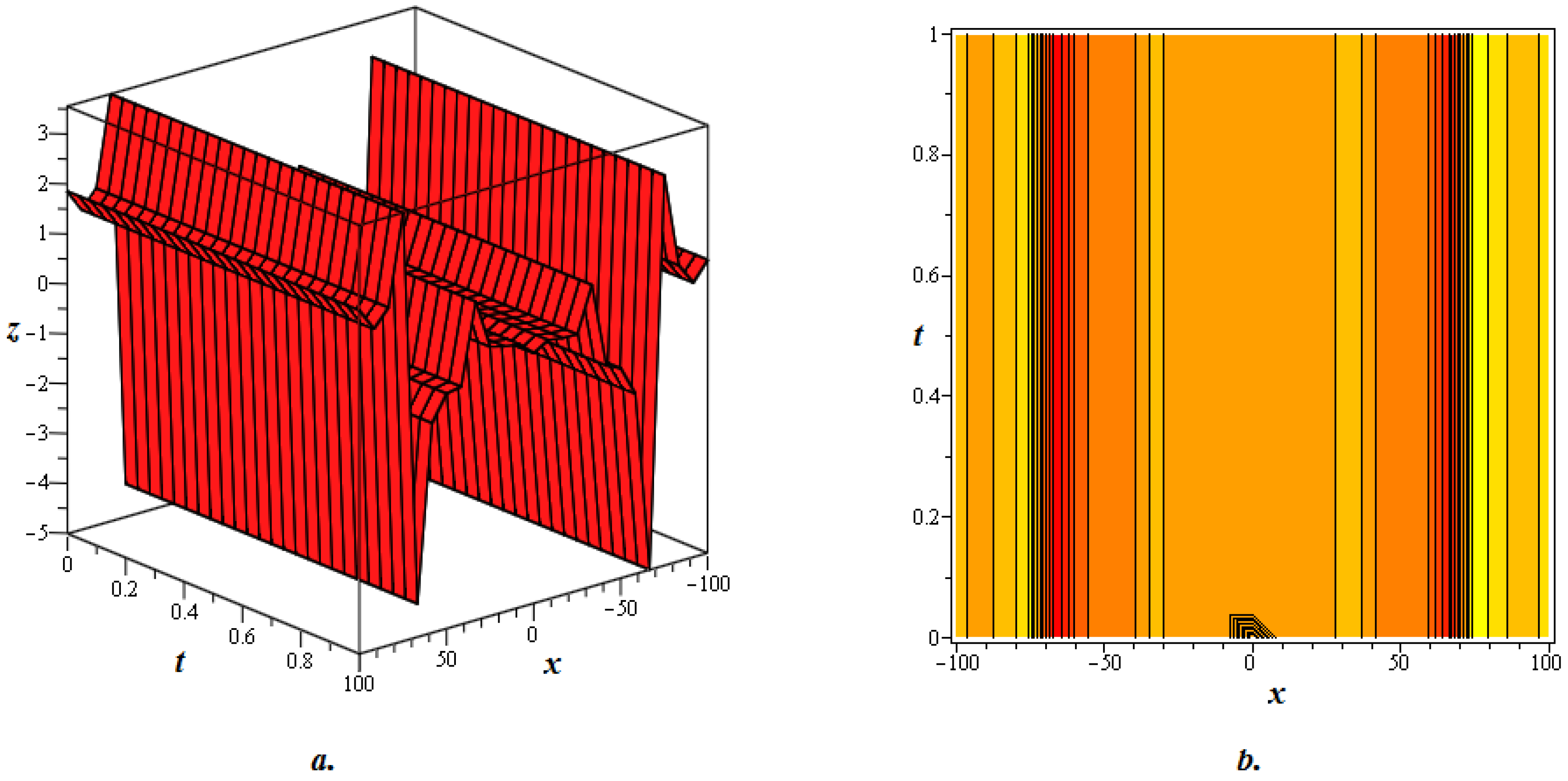

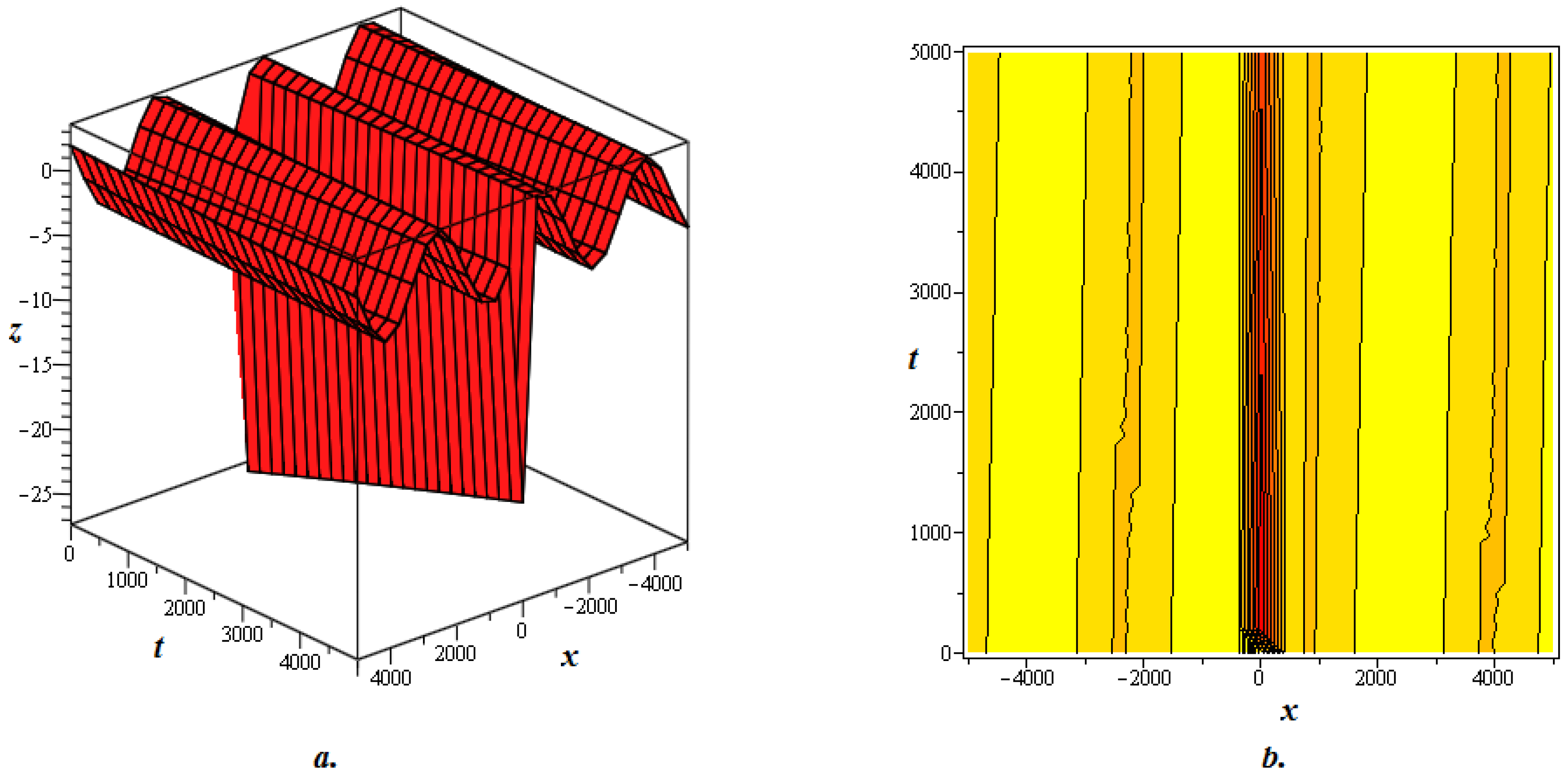

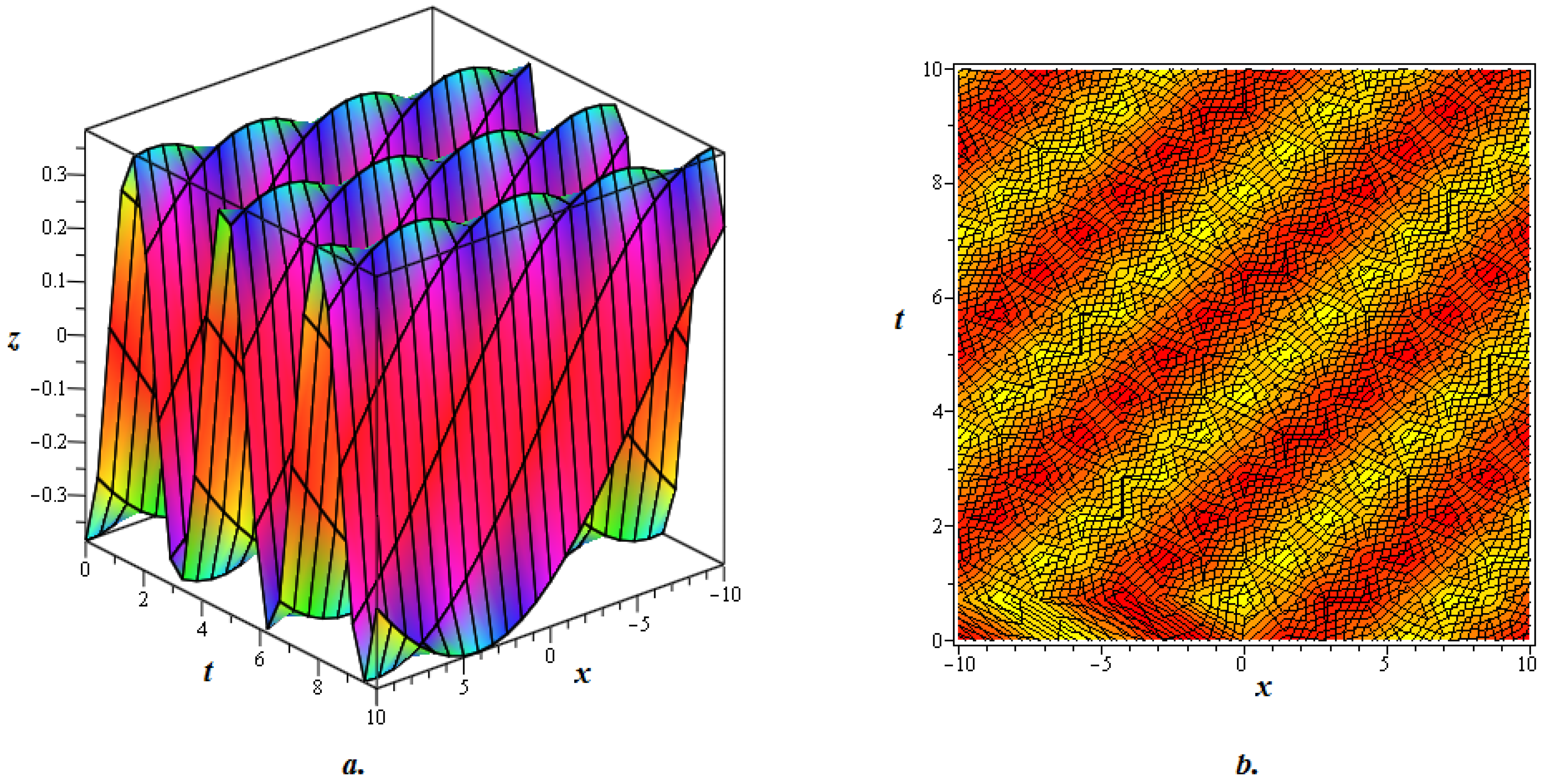
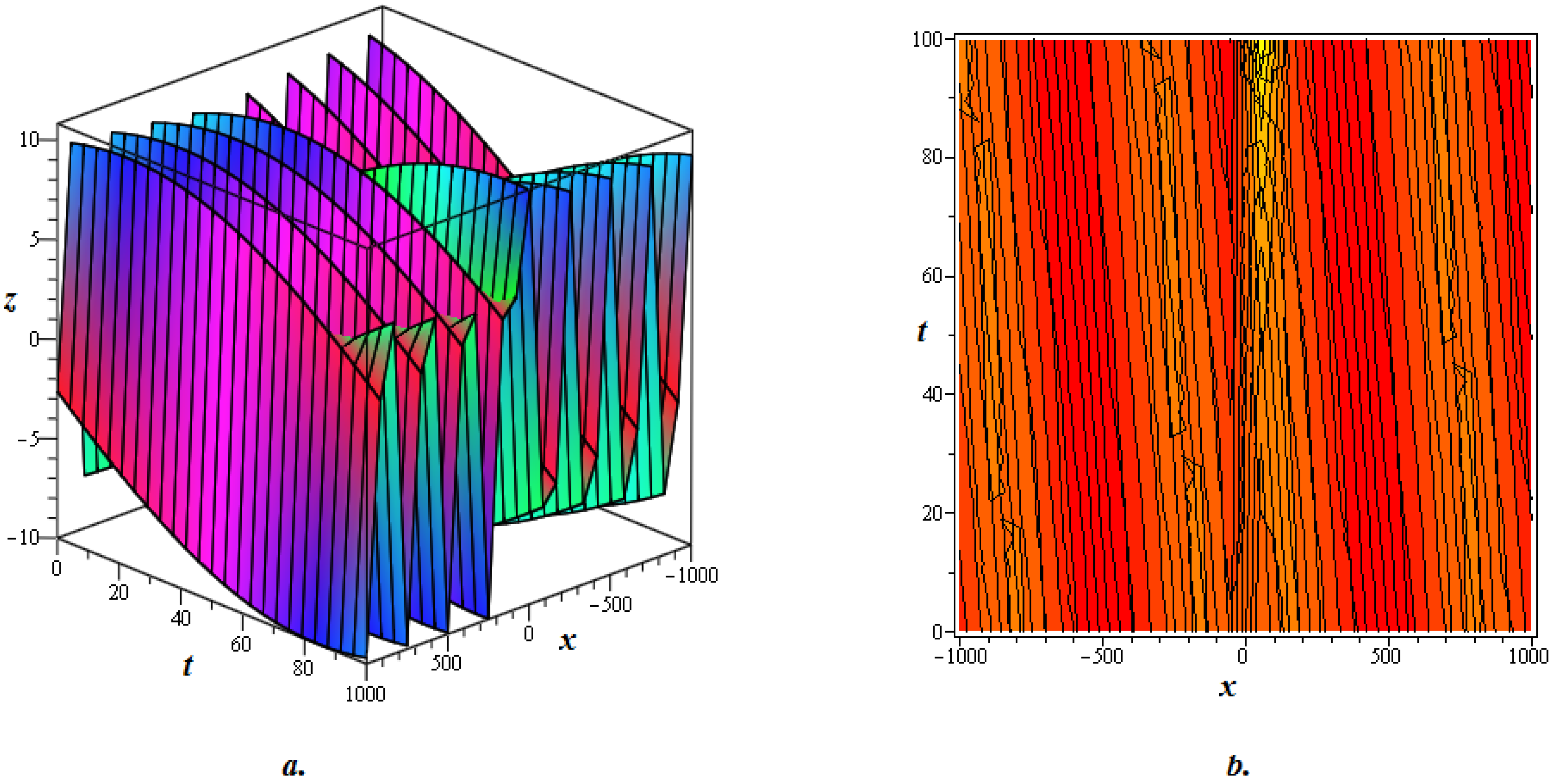
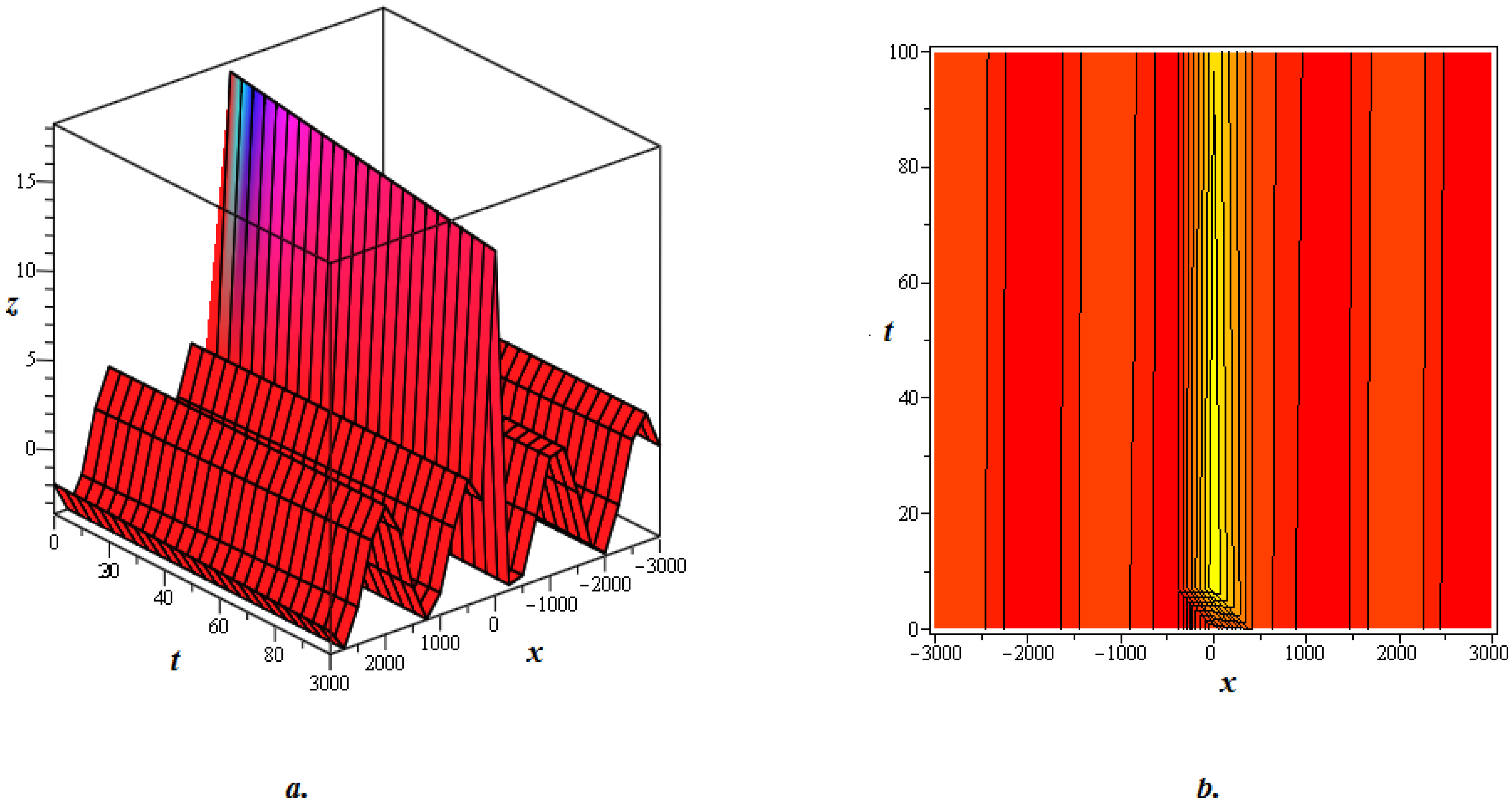

| S. No. | Family | Constraint(s) | ||
|---|---|---|---|---|
| 1 | Trigonometric Solutions | |||
| , | , | |||
| , | , | |||
| , | , | |||
| . | . | |||
| 2 | Hyperbolic Solutions | |||
| , | , | |||
| , | , | |||
| , | ||||
| . | ||||
| 3 | Rational Solutions | |||
| , | , | |||
| , & | , | , | ||
| , & | . | . | ||
| 4 | Exponential Solutions | |||
| , & , | , | , | ||
| , & , | . | . | ||
| 5 | Rational-Hyperbolic Solutions | |||
| , & , | , | , | ||
| . | . |
Disclaimer/Publisher’s Note: The statements, opinions and data contained in all publications are solely those of the individual author(s) and contributor(s) and not of MDPI and/or the editor(s). MDPI and/or the editor(s) disclaim responsibility for any injury to people or property resulting from any ideas, methods, instructions or products referred to in the content. |
© 2024 by the authors. Licensee MDPI, Basel, Switzerland. This article is an open access article distributed under the terms and conditions of the Creative Commons Attribution (CC BY) license (https://creativecommons.org/licenses/by/4.0/).
Share and Cite
Iqbal, N.; Mohammed, W.W.; Alqudah, M.; Hamza, A.E.; Hussain, S. Periodic and Axial Perturbations of Chaotic Solitons in the Realm of Complex Structured Quintic Swift-Hohenberg Equation. Math. Comput. Appl. 2024, 29, 86. https://doi.org/10.3390/mca29050086
Iqbal N, Mohammed WW, Alqudah M, Hamza AE, Hussain S. Periodic and Axial Perturbations of Chaotic Solitons in the Realm of Complex Structured Quintic Swift-Hohenberg Equation. Mathematical and Computational Applications. 2024; 29(5):86. https://doi.org/10.3390/mca29050086
Chicago/Turabian StyleIqbal, Naveed, Wael W. Mohammed, Mohammad Alqudah, Amjad E. Hamza, and Shah Hussain. 2024. "Periodic and Axial Perturbations of Chaotic Solitons in the Realm of Complex Structured Quintic Swift-Hohenberg Equation" Mathematical and Computational Applications 29, no. 5: 86. https://doi.org/10.3390/mca29050086
APA StyleIqbal, N., Mohammed, W. W., Alqudah, M., Hamza, A. E., & Hussain, S. (2024). Periodic and Axial Perturbations of Chaotic Solitons in the Realm of Complex Structured Quintic Swift-Hohenberg Equation. Mathematical and Computational Applications, 29(5), 86. https://doi.org/10.3390/mca29050086








